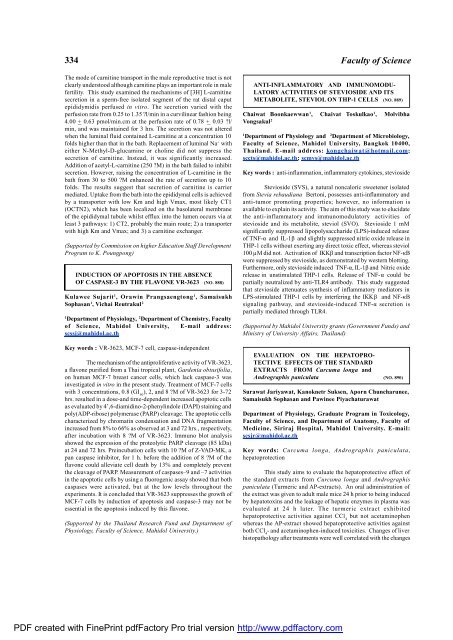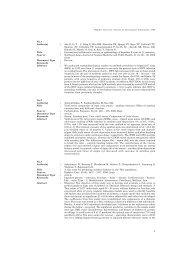Faculty of Science - Mahidol University
Faculty of Science - Mahidol University
Faculty of Science - Mahidol University
You also want an ePaper? Increase the reach of your titles
YUMPU automatically turns print PDFs into web optimized ePapers that Google loves.
334<br />
The mode <strong>of</strong> carnitine transport in the male reproductive tract is not<br />
clearly understood although carnitine plays an important role in male<br />
fertility. This study examined the mechanisms <strong>of</strong> [3H] L-carnitine<br />
secretion in a sperm-free isolated segment <strong>of</strong> the rat distal caput<br />
epididymidis perfused in vitro. The secretion varied with the<br />
perfusion rate from 0.25 to 1.35 ?l/min in a curvilinear fashion being<br />
4.00 + 0.63 pmol/min.cm at the perfusion rate <strong>of</strong> 0.78 + 0.03 ?l/<br />
min, and was maintained for 3 hrs. The secretion was not altered<br />
when the luminal fluid contained L-carnitine at a concentration 10<br />
folds higher than that in the bath. Replacement <strong>of</strong> luminal Na + with<br />
either N-Methyl-D-glucamine or choline did not suppress the<br />
secretion <strong>of</strong> carnitine. Instead, it was significantly increased.<br />
Addition <strong>of</strong> acetyl-L-carnitine (250 ?M) in the bath failed to inhibit<br />
secretion. However, raising the concentration <strong>of</strong> L-carnitine in the<br />
bath from 30 to 500 ?M enhanced the rate <strong>of</strong> secretion up to 10<br />
folds. The results suggest that secretion <strong>of</strong> carnitine is carrier<br />
mediated. Uptake from the bath into the epididymal cells is achieved<br />
by a transporter with low Km and high Vmax, most likely CT1<br />
(OCTN2), which has been localized on the basolateral membrane<br />
<strong>of</strong> the epididymal tubule whilst efflux into the lumen occurs via at<br />
least 3 pathways: 1) CT2, probably the main route; 2) a transporter<br />
with high Km and Vmax; and 3) a carnitine exchanger.<br />
(Supported by Commission on higher Education Staff Development<br />
Program to K. Poungpong)<br />
INDUCTION OF APOPTOSIS IN THE ABSENCE<br />
OF CASPASE-3 BY THE FLAVONE VR-3623 (NO. 888)<br />
Kulawee Sujarit 1 , Orawin Prangsaengtong 1 , Samaisukh<br />
Sophasan 1 , Vichai Reutrakul 2<br />
1 Department <strong>of</strong> Physiology, 2 Department <strong>of</strong> Chemistry, <strong>Faculty</strong><br />
<strong>of</strong> <strong>Science</strong>, <strong>Mahidol</strong> <strong>University</strong>, E-mail address:<br />
scssj@mahidol.ac.th<br />
Key words : VR-3623, MCF-7 cell, caspase-independent<br />
The mechanism <strong>of</strong> the antiproliferative activity <strong>of</strong> VR-3623,<br />
a flavone purified from a Thai tropical plant, Gardenia obtusifolia,<br />
on human MCF-7 breast cancer cells, which lack caspase-3 was<br />
investigated in vitro in the present study. Treatment <strong>of</strong> MCF-7 cells<br />
with 3 concentrations, 0.8 (GI 50 ), 2, and 8 ?M <strong>of</strong> VR-3623 for 3-72<br />
hrs. resulted in a dose-and time-dependent increased apoptotic cells<br />
as evaluated by 4’,6-diamidino-2-phenylindole (DAPI) staining and<br />
poly(ADP-ribose) polymerase (PARP) cleavage. The apoptotic cells<br />
characterized by chromatin condensation and DNA fragmentation<br />
increased from 8% to 66% as observed at 3 and 72 hrs., respectively,<br />
after incubation with 8 ?M <strong>of</strong> VR-3623. Immuno blot analysis<br />
showed the expression <strong>of</strong> the proteolytic PARP cleavage (85 kDa)<br />
at 24 and 72 hrs. Preincubation cells with 10 ?M <strong>of</strong> Z-VAD-MK, a<br />
pan caspase inhibitor, for 1 h. before the addition <strong>of</strong> 8 ?M <strong>of</strong> the<br />
flavone could alleviate cell death by 13% and completely prevent<br />
the cleavage <strong>of</strong> PARP. Measurement <strong>of</strong> caspases–9 and –7 activities<br />
in the apoptotic cells by using a fluorogenic assay showed that both<br />
caspases were activated, but at the low levels throughout the<br />
experiments. It is concluded that VR-3623 suppresses the growth <strong>of</strong><br />
MCF-7 cells by induction <strong>of</strong> apoptosis and caspase-3 may not be<br />
essential in the apoptosis induced by this flavone.<br />
(Supported by the Thailand Research Fund and Deptartment <strong>of</strong><br />
Physiology, <strong>Faculty</strong> <strong>of</strong> <strong>Science</strong>, <strong>Mahidol</strong> <strong>University</strong>.)<br />
<strong>Faculty</strong> <strong>of</strong> <strong>Science</strong><br />
ANTI-INFLAMMATORY AND IMMUNOMODU-<br />
LATORY ACTIVITIES OF STEVIOSIDE AND ITS<br />
METABOLITE, STEVIOL ON THP-1 CELLS (NO. 889)<br />
Chaiwat Boonkaewwan 1 , Chaivat Toskulkao 1 , Molvibha<br />
Vongsakul 2<br />
1 Department <strong>of</strong> Physiology and 2 Department <strong>of</strong> Microbiology,<br />
<strong>Faculty</strong> <strong>of</strong> <strong>Science</strong>, <strong>Mahidol</strong> <strong>University</strong>, Bangkok 10400,<br />
Thailand. E-mail address: kongchaiwat@hotmail.com;<br />
sccts@mahidol.ac.th; scmvs@mahidol.ac.th<br />
Key words : anti-inflammation, inflammatory cytokines, stevioside<br />
Stevioside (SVS), a natural noncaloric sweetener isolated<br />
from Stevia rebaudiana Bertoni, possesses anti-inflammatory and<br />
anti-tumor promoting properties; however, no information is<br />
available to explain its activity. The aim <strong>of</strong> this study was to elucidate<br />
the anti-inflammatory and immunomodulatory activities <strong>of</strong><br />
stevioside and its metabolite, steviol (SVO). Stevioside 1 mM<br />
significantly suppressed lipopolysaccharide (LPS)-induced release<br />
<strong>of</strong> TNF-α and IL-1β and slightly suppressed nitric oxide release in<br />
THP-1 cells without exerting any direct toxic effect, whereas steviol<br />
100 µM did not. Activation <strong>of</strong> IKKβ and transcription factor NF-κB<br />
were suppressed by stevioside, as demonstrated by western blotting.<br />
Furthermore, only stevioside induced TNF-α, IL-1β and Nitric oxide<br />
release in unstimulated THP-1 cells. Release <strong>of</strong> TNF-α could be<br />
partially neutralized by anti-TLR4 antibody. This study suggested<br />
that stevioside attenuates synthesis <strong>of</strong> inflammatory mediators in<br />
LPS-stimulated THP-1 cells by interfering the IKKβ and NF-κB<br />
signaling pathway, and stevioside-induced TNF-α secretion is<br />
partially mediated through TLR4.<br />
(Supported by <strong>Mahidol</strong> <strong>University</strong> grants (Government Funds) and<br />
Ministry <strong>of</strong> <strong>University</strong> Affairs, Thailand)<br />
EVALUATION ON THE HEPATOPRO-<br />
TECTIVE EFFECTS OF THE STANDARD<br />
EXTRACTS FROM Curcuma longa and<br />
Andrographis paniculata (NO. 890)<br />
Surawat Jariyawat, Kanoknetr Suksen, Aporn Chuncharunee,<br />
Samaisukh Sophasan and Pawinee Piyachaturawat<br />
Department <strong>of</strong> Physiology, Graduate Program in Toxicology,<br />
<strong>Faculty</strong> <strong>of</strong> <strong>Science</strong>, and Department <strong>of</strong> Anatomy, <strong>Faculty</strong> <strong>of</strong><br />
Medicine, Siriraj Hospital, <strong>Mahidol</strong> <strong>University</strong>. E-mail:<br />
scsjr@mahidol.ac.th<br />
Key words: Curcuma longa, Andrographis paniculata,<br />
hepatoprotection<br />
This study aims to evaluate the hepatoprotective effect <strong>of</strong><br />
the standard extracts from Curcuma longa and Andrographis<br />
paniculata (Turmeric and AP-extracts). An oral administration <strong>of</strong><br />
the extract was given to adult male mice 24 h prior to being induced<br />
by hepatotoxins and the leakage <strong>of</strong> hepatic enzymes in plasma was<br />
evaluated at 24 h later. The turmeric extract exhibited<br />
hepatoprotective activities against CCl 4 but not acetaminophen<br />
whereas the AP-extract showed hepatoprotective activities against<br />
both CCl 4 - and acetaminophen-induced toxicities. Changes <strong>of</strong> liver<br />
histopathology after treatments were well correlated with the changes<br />
PDF created with FinePrint pdfFactory Pro trial version http://www.pdffactory.com
















